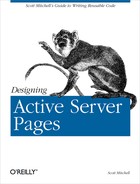This book is divided into eight chapters. The first chapter serves as an introduction to the book, describing what technologies ASP offers to aid building robust, reusable applications. This chapter introduces some of the new features in ASP 3.0 and the VBScript scripting engine that are used throughout the book to assist in application design.
The next three chapters expound on the technologies briefly discussed in the introduction. Chapter 2, discusses what scripting languages are available for designing ASP pages. The vast majority of books and ASP resource web sites present ASP examples in VBScript only. This chapter discusses some of the other languages that can be used and their advantages and disadvantages. When building an ASP application with a team of developers, there are times when a language other than VBScript needs to be used due to the various developers’ past experiences. For example, if only one of five developers is fluent with VBScript, perhaps using JScript or PerlScript as the server-side scripting language would be a better choice.
Chapter 3, examines exception-handling techniques as well as the new ASPError object introduced with ASP 3.0. Too often, when an error occurs in an ASP page, an unreadable, ugly message is displayed. With proper exception-handling techniques, these unreadable error messages can be avoided. In certain cases, errors that usually generate error messages can be “fixed” on the fly!
In Chapter 4, we look at using several of the new features available in the VBScript Scripting Engine Version 5.0. This chapter introduces VBScript classes, which are similar to classes in Visual Basic.
Chapter 5 and Chapter 6 use VBScript classes intensively to build a reusable set of classes. Chapter 5, looks at building a server-side validation class, while Chapter 6, focuses on building a generic database administration-generation class. At the conclusion of these two chapters you’ll have created a very powerful and very reusable set of classes you can use in your own ASP applications! Furthermore, classes hide the complexity of completing a task. Therefore, if you are on a team of ASP developers that contains some beginning developers, your senior developers can work on building reusable classes while your junior-level developers can spend their time using instances of these classes within ASP pages.
Chapter 7, discusses the benefits of using Microsoft-provided COM components to enhance your web site. A discussion on building custom COM components using both high-level languages and script is presented as well. Chapter 8, examines how to use preexisting COM components to add a variety of features to your site. There are literally hundreds of third-party COM components that can help you add various common web site features. Chapter 8 looks at some of the most widely used third-party components.
At the end of each chapter you’ll find a section titled “Further Reading.” This section contains a list of URLs you can visit to obtain further information on the topics discussed in the chapter.
